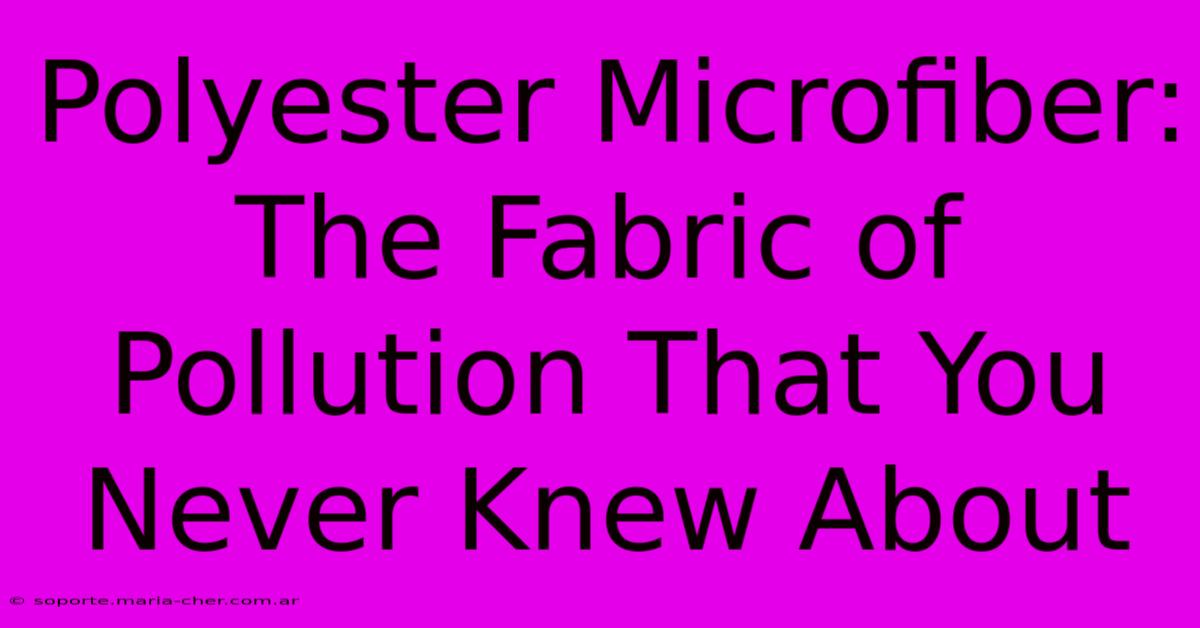Polyester Microfiber: The Fabric Of Pollution That You Never Knew About

Table of Contents
Polyester Microfiber: The Fabric of Pollution You Never Knew About
We love our soft, comfortable clothes. But have you ever stopped to consider the environmental impact of the fabrics we wear every day? This article delves into the hidden pollution problem associated with polyester microfiber, a ubiquitous fabric found in countless garments and household items.
What is Polyester Microfiber?
Polyester microfiber is a synthetic fabric made from polyethylene terephthalate (PET), a type of plastic. Its thin, fine fibers give it a soft, luxurious feel, making it incredibly popular for clothing, bedding, towels, and even cleaning cloths. While seemingly innocuous, its properties contribute significantly to a growing environmental crisis.
The Problem with Microplastics
The key issue lies in the fabric's tendency to shed microplastics. These tiny fibers, invisible to the naked eye, are released during washing, drying, and even just through general wear and tear. These microplastics then make their way into our waterways and oceans, causing widespread environmental damage.
The Environmental Impact of Polyester Microfiber
The environmental consequences of polyester microfiber pollution are far-reaching and alarming:
1. Ocean Pollution: A Growing Threat
Millions of tons of microplastics end up in our oceans annually, significantly contributing to the plastic pollution crisis. These microplastics are ingested by marine life, disrupting the food chain and harming countless species. Fish, birds, and other marine animals mistake them for food, leading to starvation, internal injuries, and ultimately, death.
2. Soil Contamination: A Hidden Danger
Microplastics aren't confined to the oceans. They also contaminate our soil, potentially impacting plant growth and the health of terrestrial ecosystems. The long-term effects of soil contamination by microplastics are still being studied, but the potential for harm is significant.
3. Human Health Concerns: A Growing Area of Research
While research is ongoing, there are growing concerns about the potential impact of microplastic ingestion on human health. We are still learning about the long-term effects of microplastics on our bodies, but preliminary studies suggest potential health risks.
What Can We Do?
The problem of polyester microfiber pollution is significant, but it's not insurmountable. We can all make a difference by taking action:
1. Reduce Your Consumption: Choose Sustainable Alternatives
Consider reducing your consumption of polyester clothing and household items. Opt for natural fabrics like cotton, linen, hemp, or organic materials whenever possible. These materials have a lower environmental impact compared to synthetic fabrics.
2. Wash Smarter: Minimize Microfiber Shedding
When washing clothes made from polyester microfiber, use a laundry bag designed to capture microplastics. This helps prevent these fibers from entering the wastewater stream. Washing clothes less frequently can also help. Consider cold water washes as warmer water can exacerbate shedding.
3. Support Sustainable Brands: Demand Transparency
Support brands committed to sustainable practices and transparent manufacturing processes. Look for companies that are actively working to reduce their environmental impact. Demand more sustainable options from retailers.
4. Advocate for Change: Raise Awareness
Spread awareness about the issue of polyester microfiber pollution. Talk to friends, family, and your community about the problem and the solutions. Contact your elected officials and urge them to support policies that address plastic pollution.
Conclusion: Making Conscious Choices
Polyester microfiber is a pervasive fabric, but its environmental consequences cannot be ignored. By understanding the problem and adopting sustainable practices, we can collectively work towards mitigating the harmful effects of this pervasive pollutant. Making conscious choices about the clothes we wear and the products we buy is a crucial step towards protecting our planet and ensuring a healthier future for all.

Thank you for visiting our website wich cover about Polyester Microfiber: The Fabric Of Pollution That You Never Knew About. We hope the information provided has been useful to you. Feel free to contact us if you have any questions or need further assistance. See you next time and dont miss to bookmark.
Featured Posts
-
Warmest Acknowledgments Embrace The Nuances Of Best Regards
Feb 09, 2025
-
Elevate Your Email Marketing With Html Signatures That Captivate And Convert
Feb 09, 2025
-
The Ultimate Watercoloring Toolkit 5 Tips And Tricks For Effortless Blending And Shadows
Feb 09, 2025
-
The Battle Of The Fabrics Microfiber Vs Polyester Which Will Reign Supreme
Feb 09, 2025
-
Design For Impact 6 Books To Elevate Your Products Value Proposition
Feb 09, 2025
